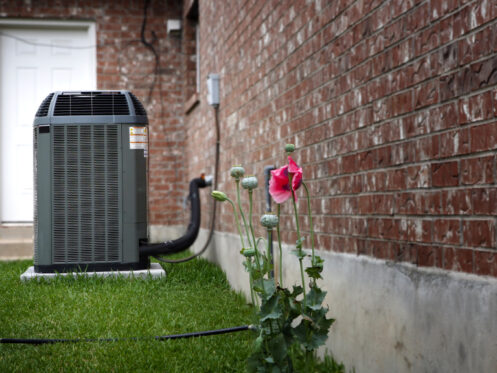Keeping your home safe and comfortable for your entire family starts with a heating and air conditioning system. Commonly referred to as Heating, Ventilation and Air Cooling (HVAC) systems, these units help to regulate you home’s temperature during the year’s wildest fluctuations. Whether you’re thinking of becoming a new homeowner or just want to learn more about these systems, we’re going to break them down into detail below.
Heating Systems
Your home heating system will be comprised of three main components. These include your wall thermostat, your distribution system and your heat source. All these three components work together to produce adequate heat for your home when you need it. The most common heat sources utilized are furnaces, boilers and heat pumps. Understanding each can allow you to best determine which one fits your needs.
Furnaces
Furnaces are by far the most popular type of heating system on the market today. This type of HVAC system will heat the air and deliver it to your rooms via a forced-air system. This is comprised of ductwork that circulates the warm air to various registers throughout your home so that each room can be adequately warmed.
Furnaces can run on fuel or electricity. Propane, natural gas and heating oil all burn to create heat that warms the air that passes over the burner. When it comes to an electric furnace, electricity is used to power an internal heating element. This heating element then warms the air that passes over it.
Boilers
While there are still many residential boilers in operation today, they were more popular a couple of decades ago. A boiler will heat water and circulate that hot water or steam through pipes. These pipes are connected to baseboards or radiators where heat is emitted into the various rooms throughout your home.
Heat Pumps
Contrary to its name, a heat pump can be used to both heat and cool a home. Instead of burning fuel, this type of system transfers heat via refrigerant undergoing pressure changes. During the winter months, heat is pulled from the air outdoors and transported into your home.
During the summer months, heat is pulled from the air indoors and transported to the outdoors. Heat pumps can be connected to ducting, or they can be ductless. Ductless heat pumps are referred to as ductless mini-split systems. They’re comprised of individual indoor handler units that are connected to one main outdoor compressor unit via piping.
Cooling Systems
The two most popular cooling systems for any home are a centralized air conditioning system and a heat pump.
With a centralized air conditioning system, warm air is circulated through the ducting to the evaporator coil located in the indoor handler unit. This evaporator coil is responsible for removing both heat and excess humidity from the air. The remaining cold air is circulated throughout your ducting and out through the registers in each room of your home.
Then, any heat is transferred to a substance known as refrigerant. This substance gets pumped to your outdoor compressor unit. With a change in pressure, heat is released from the refrigerant into the outside air.
The Thermostat
Both heating and cooling systems are controlled by a thermostat. This is typically placed on a convenient wall in your main living space. You’ll be able to toggle between heating and cooling modes depending on the season.
With a traditional thermostat, you’ll simply set a temperature. The thermostat’s built-in thermometer will constantly measure the temperature at your thermostat’s location. Whenever the temperature dips down below your desired temperature setting in the wintertime, your thermostat will signal to your heating system that it’s time to turn on. Your heating system will run to bring your home back up to your desired temperature.
The same process works for your cooling system. Anytime the thermometer in your thermostat reads that the temperature is higher than what you have set, your thermostat will signal to your cooling system that it’s time to turn on. It will run to cool your home back down to your desired temperature.
To help optimize energy savings for homeowners throughout the country, programmable and smart thermostats are available. These upgraded models allow you to set different desired temperatures depending on the time of day and the day of the week. For example, in the wintertime, you can set a lower temperature on your thermostat throughout the weekday daytime hours when no one is home. This will allow your heating system to run less throughout the day and end up saving you money on your monthly utility bills.
It’s also important to note that there are zone heating systems that work similarly to ductless mini-split units. Each zone, or mini-split unit, will have its own thermostat. This allows it to read the temperature in that specific location of your home and turn your heating or cooling system on or off depending on that specific location’s needs. These systems allow you to keep different desired temperatures in different areas, such as colder in your bedroom and warmer in your living room.
Maintenance Requirements
Both heating and air conditioning systems require regular maintenance to remote in good working order. There are things you’ll need to do as a homeowner, and there are times when you’ll need to call in an HVAC technician to help. It’s necessary to understand these maintenance needs so that you can properly take care of your units.
In the fall months, it’s necessary to call in an HVAC professional to service your heating system. They will take care of many tasks, like lubricating moving parts, checking electrical connections and so forth. Once they are done, you can be assured that your heating system is working efficiently and safely.
In the spring months, you’ll need to schedule an HVAC technician to come over to service your cooling system. They will perform tasks like checking its refrigerant level, cleaning its coils and so forth. This professional service not only helps to keep your system working efficiently but also, many times, your system manufacturer will require annual professional maintenance to keep your HVAC system under warranty.
As a homeowner, one of your biggest tasks is to monitor the air filter for your heating and cooling system. This filter is responsible for collecting unwanted airborne particles and debris. As it collects this waste, it will eventually become full. When this happens, you’ll need to remove the filter and install a new one.
It’s always advisable to check your HVAC air filter at least once a month. You’ll want to hold it up to a light source and see if you can see through it. If you can’t, then it’s time to replace it with a new one. It’s important to note that this filter will need to be checked when your air conditioning system or heating system is consistently running.
Get Professional Installation Services Today
Atticman Heating and Air Conditioning, Insulation is more than happy to provide residents of Sacramento, CA, with top-notch HVAC installation services. We’ll also be glad to assist you with all of your heating, cooling, insulation, whole-house fan, electrification, ductwork and water heater needs. Contact our office today and schedule a consultation with our experienced HVAC technicians.


